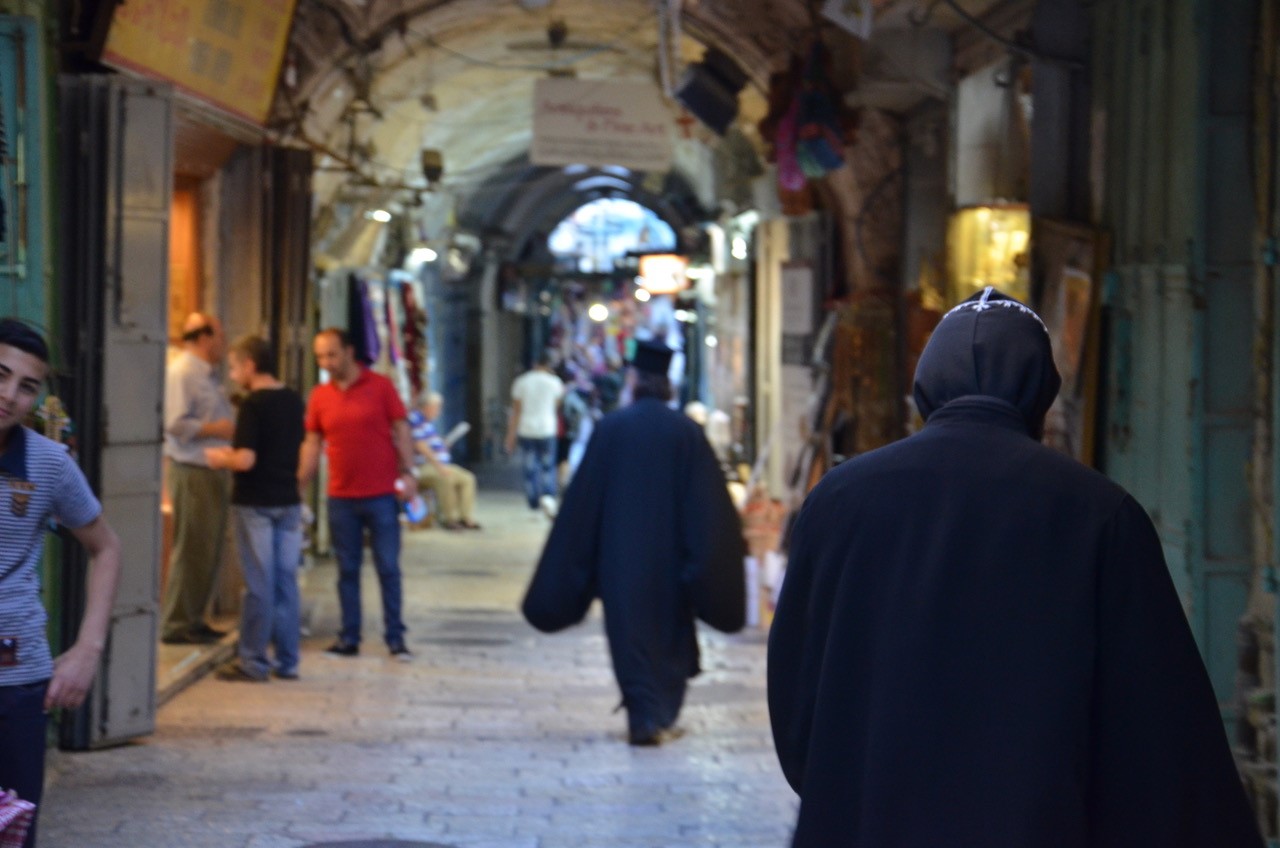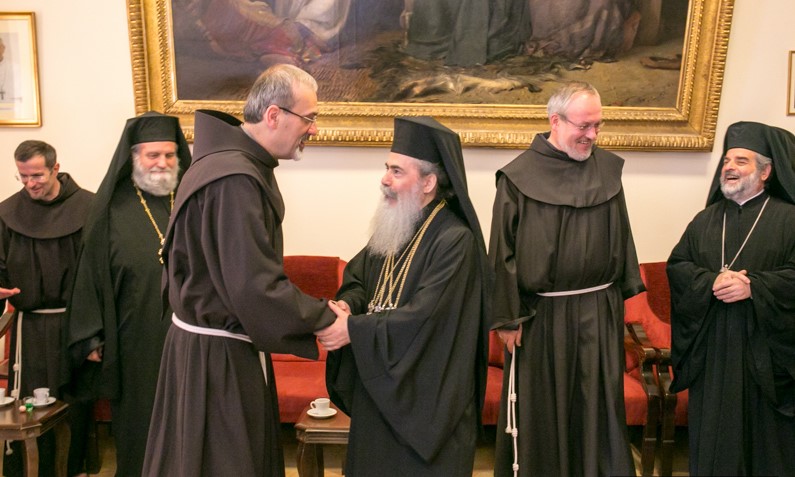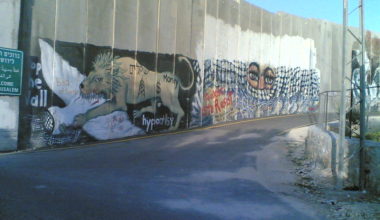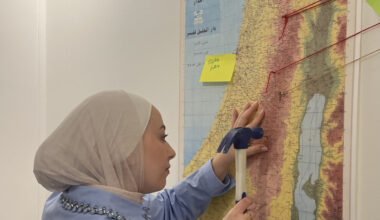
By Dr Georgios Tsourous, social anthropologist and Research Fellow at the Centre of Ethnographic Studies in the University of Kent
We found ourselves on the balcony of the Church of the Holy Sepulchre, Jerusalem.
The Edicule (the little chapel enclosing Jesus Tomb) lay gloriously beneath us in the centre of the Church. The burnished copper oil pots lined up around the Edicule caught the light of the sun, which shone through a hatch in the middle of the domed roof.
We stood at the edge of the balcony, gazing down at the vibrant environment of the Church. The continuous circular movement of pilgrims and tourists walking in and around the Edicule resembled bees working around their hive, and the sight held our gaze for a few seconds.
‘You know George, Fr Francis said, I would really like to ask you, – if you can, of course – could you include in your research that Fr Gregorios often hits me, especially whenever I pass in front of the Edicule ?!’
I stared at the Catholic Franciscan monk in disbelief, trying to discern the seriousness of this request. I was familiar with the squabbling that took place occasionally among the diverse Christian custodians in the Church of the Holy Sepulchre. In fact, stories of Greek Orthodox monks feuding with Catholic and Armenian clerics over the cleaning of such-and-such window ledge in the Church often appear in the news.
For a moment, I thought that I was seriously being asked to respond to this sensitive matter. I looked back only to see him laughing, and still faced with my disbelieving grin, he rushed to say:
‘No, it’s true! I still have some bruises!’ And with that, he pulled up the sleeve of his cassock to reveal a small bruise…
The vignette above, drawn from my doctoral research, offers a glimpse of the fieldwork reality in and around the Church of the Holy Sepulchre in the Old City of Jerusalem. With the support of CBRL, I embarked on an ethnographic journey to grasp the shifting dynamic of social relations among diverse Christians in Jerusalem. The main question that drove my research was ‘How are boundaries and borders shaped, maintained, and crossed among Jerusalem’s Christians?’

I took the research in three main ethnographic locations; the Church of the Holy Sepulchre (a major shrine of Christianity), the Greek Orthodox Patriarchate (the oldest Christian institution in the Holy Land) and the ‘street’, the neighbourhoods in the vicinity of the Old City.

By exploring how Jerusalem’s Christians navigate themselves socially, my research makes a novel contribution to understanding the material aspects of social interaction and the formation of conceptual boundaries and physical borders within diverse communities and institutions. It also addresses debates in anthropology of Christianity and its material culture.
Following anthropological methodology, I immersed myself in the daily life of the Greek Orthodox custodian monks and laymen in and around the Church of the Holy Sepulchre for 17 months (2014 – 15). Fieldwork in the Church of the Holy Sepulchre was not easy and led me to recognise that a set of factors shapes the residents’ shifting relations.

Fragile legal agreements between diverse Christian denominations (known as the ‘Status Quo’) as well as the intersection of ethnicity and theology, create a complex reality of overlapping borders and a fragile coexistence among the resident communities. In order to unpack this, I explored the Church’s shared sacred space and the ways denominational boundaries and spatial borders are maintained by the Greek custodian group.
I employ a materialist view arguing that any examination of how boundaries have been shaped between the communities will benefit from considering the material aspects of religious practices. This is because boundaries manifest themselves as very precise territorial borders around sacred shrines in the Church. Devotional objects are employed to maintain borders too (for example candlesticks) or, similarly, other items have been caught up in the communities’ complex agreements, such as for example the Immovable or Status Quo ladder (a ladder that has remained in the same place for over 200 years – see photo).

Drawing on long-term ethnographic engagement, I have argued that a focus on materiality proves that we can locate clearer boundaries between diverse religious people. It can also shed light onto how people perceive similarities and differences across boundaries and borders.
Such an analytical view became equally useful when looking at lay Palestinian Christians in the ‘street’, the vicinity of the Old City. Local Christians interact in ways that push beyond the denominational boundaries witnessed in the Church. They cross spatial borders, attending each other’s services and engaging in a variety of what I have called ‘border- crossing practices’ – practices that diverge from approved practice (Tsourous, 2015). While some (Palestinian) Orthodox often perceive the Church’s borders as problematic, others border-cross in amongst the Christian denominations to mark differentiation with Muslim and Jewish groups in the Old City and maintain this way their collective standing.
My ethnographic account of intra-communal boundaries also expands on the politics of identity and coexistence around shared sacred spaces. I argue that interactions among individuals cannot not be seen as merely proxies for interactions between wider social groups (for example, in our case, the Greek Orthodox Church, the Catholic Church, the State of Israel etc.). This can be understood better by looking at everyday co-habitation and grassroots activities of social actors, as they struggle to co-exist in the same space.

I have argued that focusing on the grassroots activities enables researchers to move through various scales of analysis, shifting from a perspective that focuses on essentialised groups to one that pays attention to individual actors. This allows us to examine various frameworks of anthropological interpretation without essentialising the processes of social life (Henig, 2016).
In that sense, I have aimed to look at ‘what people are doing, and what they say they are doing, while they are in the process of doing it’ (Bowman, 2010: 198). By exploring processes of contestation on the grassroots level, my thesis proves that shared sacred spaces cannot become indices of the qualities of wider inter-religious relations.
The analytical framework developed in my thesis informed subsequent research on Christian/Muslim interaction in shared sacred sites (Church of Saint George al-Khader near Bethlehem) and developing research with Muslim refugees in Greece. As I continue research in the region, I remain grateful to CBRL for its support as well as to colleagues and friends at Jerusalem’s Kenyon Institute, an integral part of academic life in Israel/Palestine.
References:
Bowman, G. (2010) ‘Orthodox-Muslim Interactions at ‘Mixed Shrines’ in Macedonia’. In C. Hann, C. & H. Goltz (eds.), Eastern Christians in Anthropological Perspective. Berkeley, CA: University of California Press, pp. 195–219.
Henig, D. (2016). ‘Contested Choreographies of Sacred Spaces in Muslim Bosnia’. In E. Barkan & K. Barkey (eds.), Choreographies of Shared Sacred Sites: Religion, Politics, and Conflict Resolution, NY: Columbia University Press, pp. 130-160.
Tsourous, G. 2015. ‘Border Crossing and Symbiotic Relationships between Christians in Jerusalem’.
In Bulletin for the Council for British Research in the Levant, 10(1), pp. 37–41. DOI:10.1179/1752726015Z.00000000030
Dr Georgios Tsourous is a social anthropologist and a Research Fellow at the Centre of Ethnographic Studies in the University of Kent. His ethnographic research, funded by the CBRL, involved the investigation of the material aspects of social interaction and the formation of boundaries and borders between the Christian communities in Jerusalem with a focal point the Church of the Holy Sepulchre in the Old City.
The views expressed by our authors on the CBRL blog are not necessarily endorsed by CBRL, but are commended as contributing to public debate.















